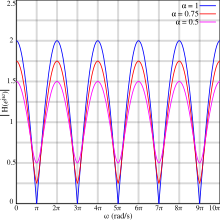Comb filter

Insignal processing,acomb filteris afilterimplemented by adding a delayed version of asignalto itself, causing constructive and destructiveinterference.Thefrequency responseof a comb filter consists of a series of regularly spaced notches in between regularly spacedpeaks(sometimes calledteeth) giving the appearance of acomb.
Comb filters exist in two forms,feedforwardandfeedback;which refer to the direction in which signals are delayed before they are added to the input.
Comb filters may be implemented indiscrete timeorcontinuous timeforms which are very similar.
Applications
[edit]
Comb filters are employed in a variety of signal processing applications, including:
- Cascaded integrator–comb(CIC) filters, commonly used foranti-aliasingduringinterpolationanddecimationoperations that change thesample rateof a discrete-time system.
- 2D and 3D comb filters implemented in hardware (and occasionally software) inPALandNTSCanalog television decoders, reduce artifacts such asdot crawl.
- Audio signal processing,includingdelay,flanging,physical modelling synthesisanddigital waveguide synthesis.If the delay is set to a few milliseconds, a comb filter can model the effect ofacousticstanding wavesin a cylindrical cavity orin a vibrating string.
- In astronomy theastro-combpromises to increase the precision of existingspectrographsby nearly a hundredfold.
Inacoustics,comb filtering can arise as an unwanted artifact. For instance, twoloudspeakersplaying the same signal at different distances from the listener, create a comb filtering effect on the audio.[1]In any enclosed space, listeners hear a mixture of direct sound and reflected sound. The reflected sound takes a longer, delayed path compared to the direct sound, and a comb filter is created where the two mix at the listener.[2]Similarly, comb filtering may result from mono mixing of multiple mics, hence the 3:1rule of thumbthat neighboring mics should be separated at least three times the distance from its source to the mic.[citation needed]
Discrete time implementation
[edit]Feedforward form
[edit]
The general structure of a feedforward comb filter is described by thedifference equation:
whereis the delay length (measured in samples), andαis a scaling factor applied to the delayed signal. Theztransformof both sides of the equation yields:
Thetransfer functionis defined as:
Frequency response
[edit]

The frequency response of a discrete-time system expressed in thez-domain is obtained by substitutionwhereis theimaginary unitandisangular frequency.Therefore, for the feedforward comb filter:
UsingEuler's formula,the frequency response is also given by
Often of interest is themagnituderesponse, which ignores phase. This is defined as:
In the case of the feedforward comb filter, this is:
Theterm is constant, whereas theterm variesperiodically.Hence the magnitude response of the comb filter is periodic.
The graphs show the periodic magnitude response for various values ofSome important properties:
- The response periodically drops to alocal minimum(sometimes known as anotch), and periodically rises to alocal maximum(sometimes known as apeakor atooth).
- For positive values ofthe first minimum occurs at half the delay period and repeats at even multiples of the delay frequency thereafter:
- The levels of the maxima and minima are always equidistant from 1.
- Whenthe minima have zero amplitude. In this case, the minima are sometimes known asnulls.
- The maxima for positive values ofcoincide with the minima for negative values of,and vice versa.
Impulse response
[edit]The feedforward comb filter is one of the simplestfinite impulse responsefilters.[3]Its response is simply the initial impulse with a second impulse after the delay.
Pole–zero interpretation
[edit]Looking again at thez-domain transfer function of the feedforward comb filter:
the numerator is equal to zero wheneverzK= −α.This hasKsolutions, equally spaced around a circle in thecomplex plane;these are thezerosof the transfer function. The denominator is zero atzK= 0,givingKpolesatz= 0.This leads to apole–zero plotlike the ones shown.
 |
 |
Feedback form
[edit]
Similarly, the general structure of a feedback comb filter is described by thedifference equation:
This equation can be rearranged so that all terms inare on the left-hand side, and then taking theztransform:
The transfer function is therefore:
Frequency response
[edit]

By substitutinginto the feedback comb filter'sz-domain expression:
the magnitude response becomes:
Again, the response is periodic, as the graphs demonstrate. The feedback comb filter has some properties in common with the feedforward form:
- The response periodically drops to a local minimum and rises to a local maximum.
- The maxima for positive values ofcoincide with the minima for negative values ofand vice versa.
- For positive values ofthe first maximum occurs at 0 and repeats at even multiples of the delay frequency thereafter:
However, there are also some important differences because the magnitude response has a term in thedenominator:
- The levels of the maxima and minima are no longer equidistant from 1. The maxima have an amplitude of1/1 −α.
- The filter is onlystableif|α|is strictly less than 1. As can be seen from the graphs, as|α|increases, the amplitude of the maxima rises increasingly rapidly.
Impulse response
[edit]The feedback comb filter is a simple type ofinfinite impulse responsefilter.[4]If stable, the response simply consists of a repeating series of impulses decreasing in amplitude over time.
Pole–zero interpretation
[edit]Looking again at thez-domain transfer function of the feedback comb filter:
This time, the numerator is zero atzK= 0,givingKzeros atz= 0.The denominator is equal to zero wheneverzK=α.This hasKsolutions, equally spaced around a circle in thecomplex plane;these are the poles of the transfer function. This leads to a pole–zero plot like the ones shown below.
 |
 |
Continuous time implementation
[edit]Comb filters may also be implemented incontinuous timewhich can be expressed in theLaplace domainas a function of thecomplexfrequency domain parameteranalogous to the z domain.Analog circuitsuse some form ofanalog delay linefor the delay element. Continuous-time implementations share all the properties of the respective discrete-time implementations.
Feedforward form
[edit]The feedforward form may be described by the equation:
whereτis the delay (measured in seconds). This has the following transfer function:
The feedforward form consists of an infinite number of zeros spaced along the jω axis (which corresponds to the Fourier domain).
Feedback form
[edit]The feedback form has the equation:
and the following transfer function:
The feedback form consists of an infinite number of poles spaced along the jω axis.
See also
[edit]References
[edit]- ^Roger Russell."Hearing, Columns and Comb Filtering".Retrieved2010-04-22.
- ^"Acoustic Basics".Acoustic Sciences Corporation. Archived fromthe originalon 2010-05-07.
- ^Smith, J. O."Feedforward Comb Filters".Archived fromthe originalon 2011-06-06.
- ^Smith, J.O."Feedback Comb Filters".Archived fromthe originalon 2011-06-06.
External links
[edit] Media related toComb filtersat Wikimedia Commons
Media related toComb filtersat Wikimedia Commons

![{\displaystyle y[n]=x[n]+\alpha x[n-K]}](https://wikimedia.org/api/rest_v1/media/math/render/svg/407d8d32def12f79789bde99eccb4d859fd98281)







![{\displaystyle H\left(e^{j\omega }\right)={\bigl [}1+\alpha \cos(\omega K){\bigr ]}-j\alpha \sin(\omega K)}](https://wikimedia.org/api/rest_v1/media/math/render/svg/7a4500af1719c579363396c75f6f633b01eea232)










![{\displaystyle y[n]=x[n]+\alpha y[n-K]}](https://wikimedia.org/api/rest_v1/media/math/render/svg/aab660dee16e819787a26d5de6162532f6da0da3)












